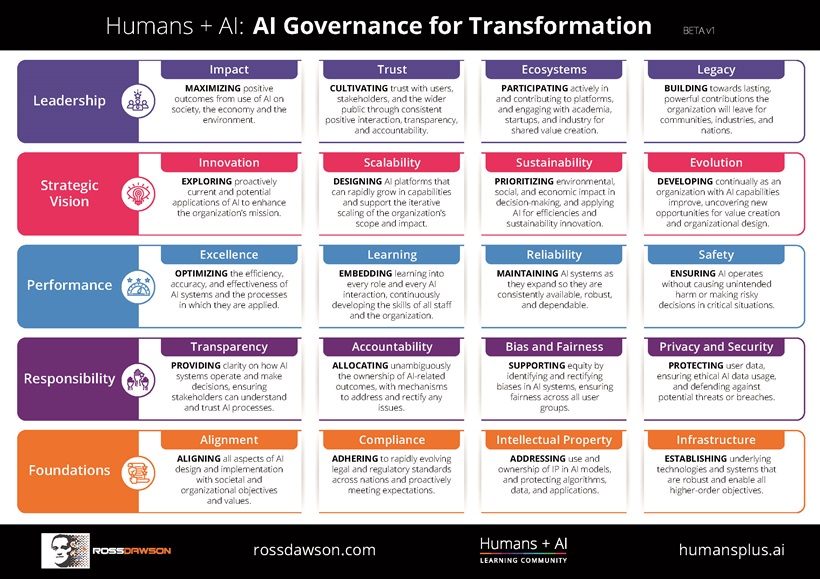Humans + AI resources > Humans + AI: AI Governance for Transformation
To tap the full potential of Humans + AI:
Check out Ross Dawson’s Maven cohort course on AI-Enhanced Thinking and Decision-Making. Next cohort starts soon!
Join the Humans + AI Learning Community for collaborative learning, AI courses, member events, and more.
Use the ThoughtWeaver app to maximize your Humans + AI productivity.
Humans + AI: AI Governance for Transformation
The fundamental elements of AI governance that enables organizational transformation.
 Click Click on the image for the full size pdf.
Click Click on the image for the full size pdf.
Leadership:
- Impact: Maximizing positive outcomes from use of AI on society, the economy and the environment.
- Trust: Cultivating trust with users, stakeholders, and the wider public through consistent positive interaction, transparency, and accountability.
- Ecosystems: Participating actively in and contributing to platforms, and engaging with academia, startups, and industry for shared value creation.
- Legacy: Building towards lasting, powerful contributions the organization will leave for communities, industries, and nations.
Strategic Vision:
- Innovation: Exploring proactively current and potential applications of AI to enhance the organization’s mission.
- Scalability: Designing AI platforms that can rapidly grow in capabilities and support the iterative scaling of the organization’s scope and impact.
- Sustainability: Prioritizing environmental, social, and economic impact in decision-making, and applying AI for efficiencies and sustainability innovation.
- Evolution: Developing continually as an organization with AI capabilities improve, uncovering new opportunities for value creation and organizational design.
Performance:
- Excellence: Optimizing the efficiency, accuracy, and effectiveness of AI systems and the processes in which they are applied.
- Learning: Embedding learning into every role and every AI interaction, continuously developing the skills of all staff and the organization.
- Reliability: Maintaining AI systems as they expand so they are consistently available, robust, and dependable.
- Safety: Ensuring AI operates without causing unintended harm or making risky decisions in critical situations.
Responsibility:
- Transparency: Providing clarity on how AI systems operate and make decisions, ensuring stakeholders can understand and trust AI processes.
- Accountability: Allocating unambiguously the ownership of AI-related outcomes, with mechanisms to address and rectify any issues.
- Bias and Fairness: Supporting equity by identifying and rectifying biases in AI systems, ensuring fairness across all user groups.
- Privacy and Security: Protecting user data, ensuring ethical AI data usage, and defending against potential threats or breaches.
Foundations:
- Alignment: Aligning all aspects of AI design and implementation with societal and organizational objectives and values.
- Compliance: Adhering to rapidly evolving legal and regulatory standards across nations and proactively meeting expectations.
- Intellectual Property: Addressing use and ownership of IP in AI models, and protecting algorithms, data, and applications.
- Infrastructure: Establishing underlying technologies and systems that are robust and enable all higher-order objectives.
